The Ladies Who Busted Broncs
Montana Rodeo Girls...
Montana cowboys say that rodeos weren’t born, “they just growed” out of custom and necessity. And nowhere is there a richer rodeo heritage than where the Big Sky meets the rolling prairie. Montana has bred some of the best cowboys and meanest mounts as well as some of the West’s most famous women riders. Four of these Montana women bucked their way to renown as rodeo came into its own. Fannie Sperry Steele, Marie Gibson, and Alice and Marge Greenough were all world-class champions tough to top. Each wore her laurels with a grace and dignity that belied her chosen path.
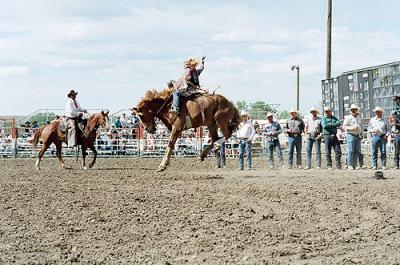
Fannie Sperry Steele and Marie Gibson were products of the late 19th century that saw the West’s cattle ranches begin to industrialize. As the Northern Pacific steamed from Glendive to Helena across America’s last frontier in 1883, barbed wire encroached on the open range. Overland cattle drives, once a necessity to move Montana’s livestock to market, became a thing of the past. Ranches needed fewer hands and cowboys saw their way of life passing into legend.
A genre emerged that employed cowboys when ranches did not. Wild West shows marketed cowboy skills as entertainment showcasing horsemanship, trick riding, and expert shooting. These shows took the “Old West” across the country and to European audiences. At home in Montana, state and local fairs provided an outlet for homegrown cowboys, and cowgirls, on rural homesteads to show off their skills.
Fannie Sperry grew up with these competitive cowboy traditions. Born on a homestead beneath the picturesque Sleeping Giant in the Prickly Pear Valley in 1887, Fannie’s mother taught her to ride almost before she could walk and gave her a fierce love of horses. Fannie cast aside Victorian decorum and rode astride in a divided skirt. She rounded up the wild horses and rode the roughest ones with the best of the men.
Local ranch kids gathered like the cowhands of days gone by, holding Sunday afternoon competitions with neighbors. During these impromptu exhibitions, Fannie earned a reputation for courage, skill, grit, and sticking power on the back of the wildest bucking broncos. At one of these competitions in the summer of 1903, sixteen-year-old Fannie awed spectators with such a ride on a bucking white stallion that onlookers passed the hat.
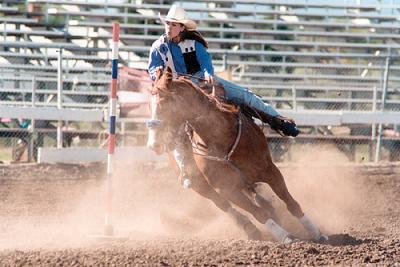
At the Montana State Fair in Lewis and Clark County in 1904, Fannie Sperry made her first professional ride, not on a bucking bronco, but as a relay racer. Inspired by Buffalo Bill’s “Pony Express Race,” the Montana relay featured only women riders and thoroughbreds. Riders changed horses and saddles at top speed. Fannie rode the very first relays at Helena, Butte and Anaconda. Butte promoter Walter R. Wilmot signed Fannie, her friend Christine Synness, and several other Montana ladies to ride relays across the Midwest in 1905. The popular “Montana Girls” did very well, and Fannie earned a medal for meritorious riding. In 1907, she began to ride in women’s bucking horse competitions. Fannie earned a gold medal in Helena as women’s bucking horse champion. Then at the Calgary Stampede in 1912, her ride on the killer bronc Red Wing went down in rodeo history earning her the title, “Lady Bucking Horse Champion of the World.” She earned the title again in 1913.
Unlike most other bronc-busting women of the time, Fannie Sperry rode “slick” instead of hobbled. Hobbling was a concession allowed women contestants and most rode thus, their stirrups tied together beneath the horse’s belly for greater stability in the saddle. But hobbling was very dangerous in the event of a tumble for the rider could not kick free. Fannie viewed hobbling as unfair to the horse since it did not give the animal a fifty-fifty chance of bucking off its rider. Slick riding, however, demanded precision, balance, courage, and unusual strength. Fannie was the only woman rider among her contemporaries to ride her entire career slick, just like her male counterparts.
Fannie married bronc rider and rodeo clown Bill Steele in 1913. The couple traveled the rodeo circuit and performed with Buffalo Bill Cody in 1916 at one of Cody’s last headlining appearances. Although Fannie continued to ride exhibition broncs until she was in her 50s, her last competition was at Bozeman in 1925. After Bill died in 1940, Fannie ran their Helmville ranch alone for another 25 years. She was the first woman in Montana to receive a packer’s license, and with her string of pintos, guided hunters on trips into the mountains.
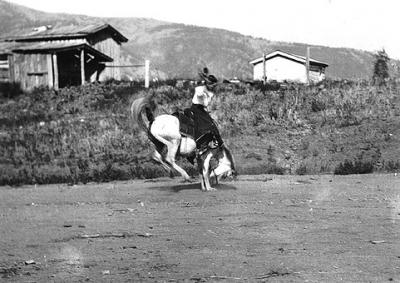
Other courageous Montana women made for stiff competition during Fannie’s professional career in the 1910s and 1920s. Paris Williams of Billings, Violet and Margaret Brander of Avon, Peggy Warren of Victor, Princess Red Bird of Arlee, and Marie Gibson of Havre all displayed remarkable courage climbing onto the backs of a wild, unbroken broncos. The men and women who rode the rangy, erratic animals well knew the dangers; any ride could end badly. Havre legend Marie Gibson illustrates the deadly unpredictability.
Marie, born in 1894 in Canada, married at sixteen but joined her parents on their homestead near Havre in 1914. With the encouragement of neighbors, including legendary cowboy Long George Francis, Marie began trick riding in local fairs and rodeos for prize money to help support her children. Her professional debut came in 1917 at Havre’s Great Stampede. Divorced from her first husband, she married rodeo veteran Tom Gibson in 1919. Gibson retired to the homestead and Marie went on to travel widely, busting broncs overseas and back East. During a performance in England she so charmed the Prince of Wales that he presented her with a prize horse. Marie earned many titles including World Champion Cowgirl Bronc Rider in 1924 and 1927.
Marie had just made a successful ride on a wild bronc in Idaho in 1933. The horse was still bucking as the pickup man approached to take her off. The two horses collided and Marie’s horse lost his balance and fell on her, fatally fracturing her skull. Her hobbled stirrups prevented her from kicking free. Her son Lucien, then 23, later wrote a friend, “I was the first man to her.” Marie is buried in Havre where locals rightfully claim her as one of their own.
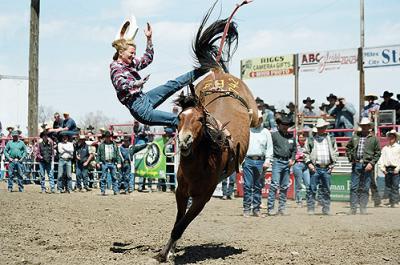
After World War I, rodeo became its own genre, taking its formal elements—the grand entry, clowns and trick riding—from the disappearing Wild West shows. Fannie Sperry Steele and Marie Gibson, who both performed in the early rodeos and Wild West type entertainments, were the first generation of professional Montana cowgirls. They witnessed the transition as rodeo matured into a profession and communities across Montana began to establish the events like Havre’s Great Northern Stampede and the Home of Champions Rodeo at Red Lodge that still draw tourists today.
As the first national professional rodeo organization formed in 1929 with men and women as members, Marge and Alice Greenough of Red Lodge bridged the final transition between the Old West and the modern era. Their father, “Packsaddle Ben” Greenough, was a local character who guided seasonal sportsmen into the Beartooth Mountains. The Greenoughs kept horses by the hundreds and a rock-littered corral at their base camp served as a playground. Ben expected his children to gentle the wildest horses. They learned their craft out of necessity. “Nobody,” Marge reflected, “could get bucked off in those rocks and live.”
Alice was seventeen when she rode her first bronc in public at the Forsyth Rodeo in 1919. Marge, five years younger, won a $15 purse for the half-mile cowgirl race held in the park at the Red Lodge rodeo in 1924. Marge jockeyed and later rode bareback broncs and steers while Alice did exceptional trick riding. Both sisters eventually rode bucking broncos and bulls, and won many championships across the United States. Alice traveled world-wide demonstrating her skills.
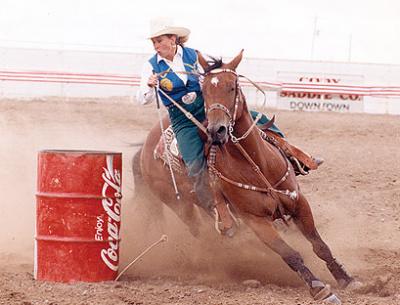
The Greenough sisters were refined, well-spoken, and dressed like ladies when they were not riding. They carried their sewing machine on the road and made their own clothes. They endured the same struggles as their male counterparts, suffered the same injuries, and rode the same horses. The Greenough sisters, their saddle-bronc champion brother Turk, and other family members helped bring the professional Home of Champions Rodeo to Red Lodge. After Alice and Marge retired, they moved to Arizona where they were involved in the film industry, but Montanans know they hailed from Red Lodge.
These four spirited, independent women are all members of the National Cowboy Hall of Fame. Among the 266 members, thirty-three are women and only twelve rode broncs. Fannie Sperry Steele honored in 1975, Alice and Marge Greenough in 1983, and Marie Gibson posthumously in 2006, are quintessential Montana women who take their places among the best of the best.
Women rarely ride broncs any more. According to Larry Jordan, whose Jordan Rodeo Company provided horses for rodeos in the United States and Canada, contemporary stock cannot be compared to that of the early twentieth century. Today’s horses are bred to be larger and more powerful. Although perhaps not as wild as the rangy, untamed stock of the past, it takes a large frame to ride them. Women do have the opportunity, but most focus on other kinds of skills. All-girl, high school, and college rodeos offer roping and riding events for women, but the only women’s event currently sanctioned by the Professional Rodeo Cowboy Association (PRCA) is barrel racing. Credit goes to Alice Greenough for forming her own rodeo company in order to feature the first women’s barrel racing competitions.
The days of the range and cowboy gatherings after roundup might be gone, but the skills they perfected flourish across the West as sport and entertainment. Montana offers spectacular rodeos in every corner of the state, in nearly every month of the year. From the famous Miles City Bucking Horse Sale in May to the Pro Rodeo Circuit Finals at Great Falls in January, rodeo not only preserves a part of the West as it was once, but also promotes it as it is today. Women, and men, of the Treasure State gave uniquely to its growth. Montana’s modern cowboys and cowgirls are the first to express their admiration for those remarkable bronc busting women of yesterday.
~ Ellen Baumler is the Montana Historical Society’s interpretive historian and an award-winning author. She is in demand as a lecturer, teacher, tour guide, and storyteller, especially of Montana ghost stories. To be a cowgirl, however, is her secret dream.






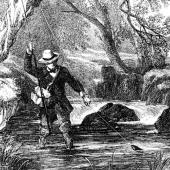





- Reply
Permalink